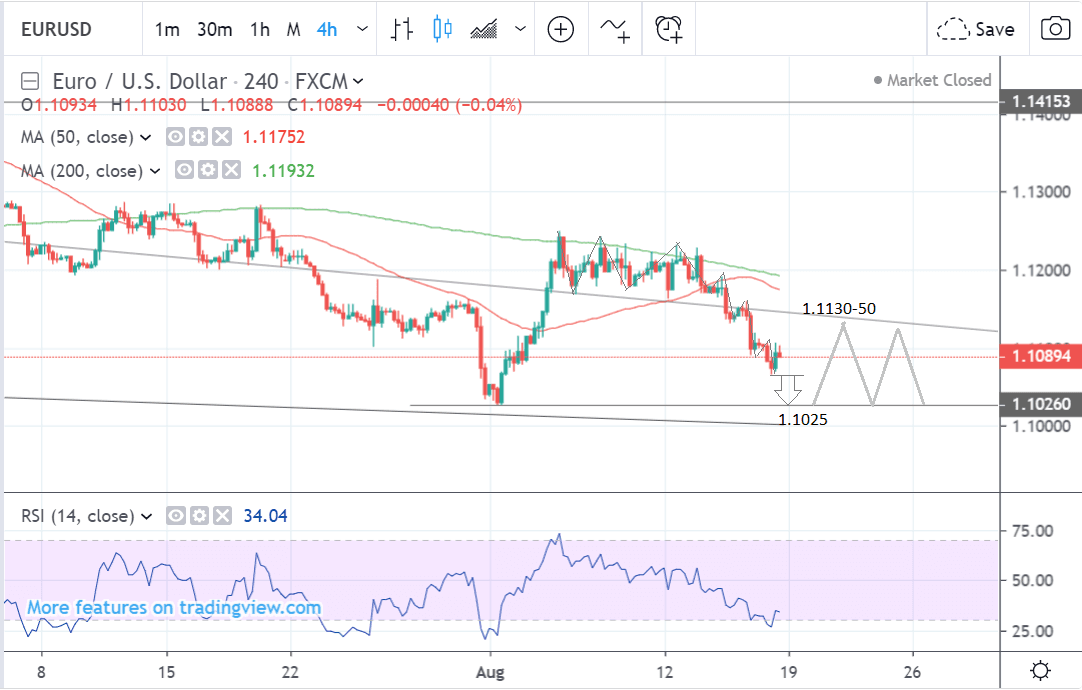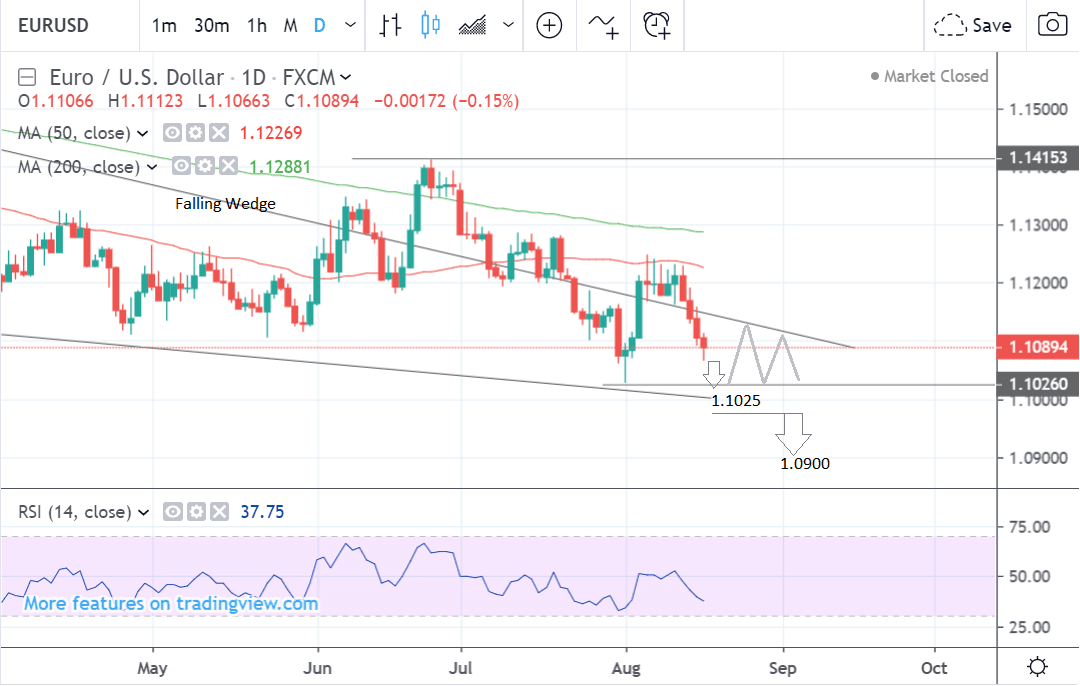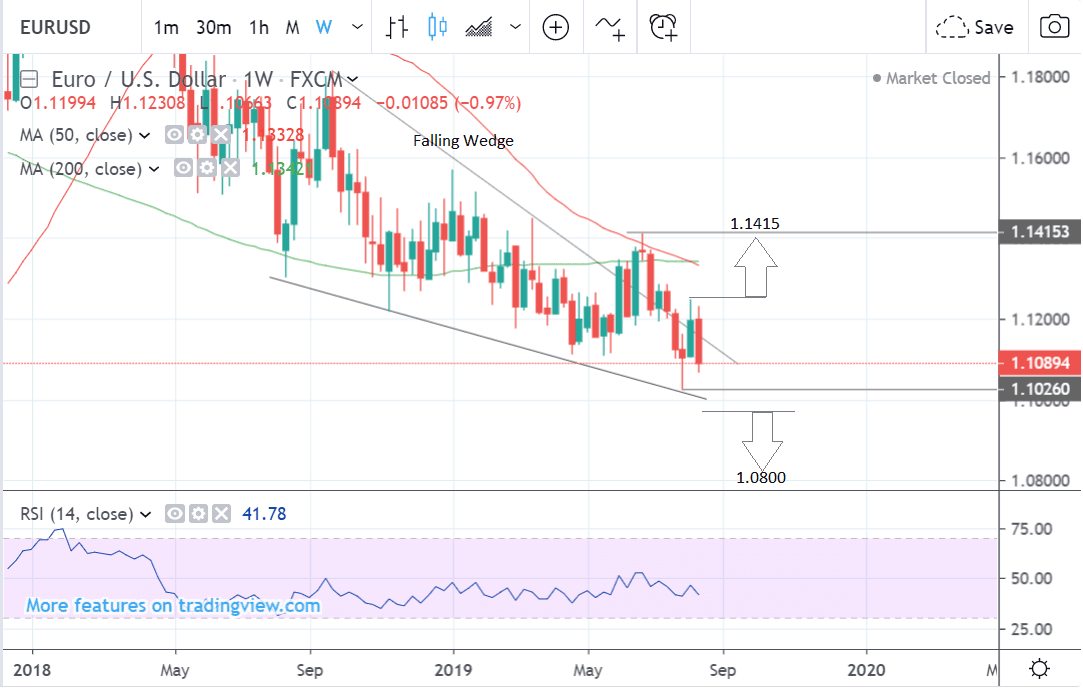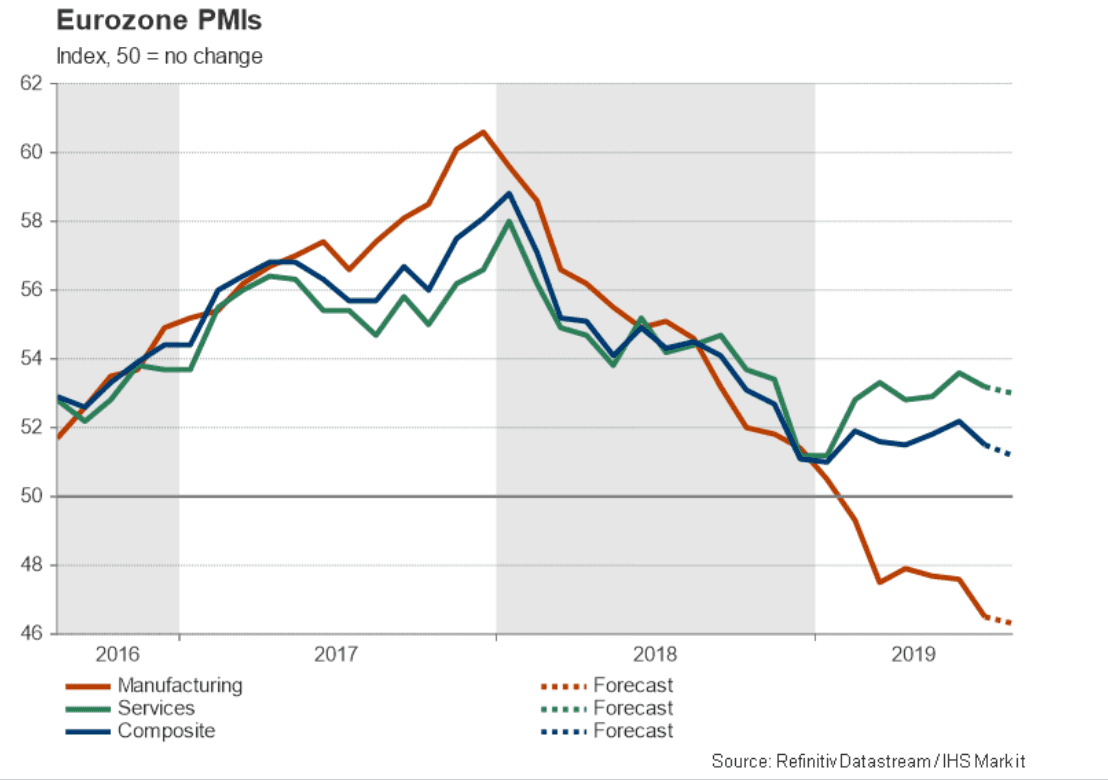EUR/USD Week Ahead Forecast: Trend Flips Lower Again

Image © Adobe Images
- EUR/USD stops rising, reverses, and starts falling
- Potential for return back down to 2019 lows
- Both Euro and U.S. Dollar to be driven by PMIs
The Euro-to-Dollar rate is trading at around 1.1088 at the start of the new week, after falling 0.97% in the week before.
Studies of the charts are showing the short-term trend has flipped again and probably begun to decline, and this suggests more downside is likely in the future - although given the highly random nature of recent moves, this is not a confidence call.
The 4 hour chart - used to determine the short-term outlook, which includes the coming week or next 5 days - shows the pair having broken down after consolidating in a sideways pattern.
The capitulation, which has now lasted all week, has completed two sets of lower lows (HH) and lower highs (HL) which is one of the first indications of the onset of new downtrend. Given the market maxim that ‘the trend is your friend’ the pair may now be biased to go even lower.
A break below 1.1066 is likely to lead to a move down to a target at 1.1025 and the year’s lows. Here it is likely to encounter support, as historic lows often have a support and resistance effect.
The daily chart shows how the pair has broken down after briefly asserting itself above the top of the long-term wedge and finding resistance at the 50-day moving average (MA).
The surprising 4 day decline has in many ways set the tone of the market and we see more downside possible to a target at 1.0900 potentially. Such a move would have to break below the 1.0975 level, however, to gain confirmation.
The daily chart is used to give us an indication of the outlook for the medium-term, defined as the next week to a month ahead.
The weekly chart - used to give us an idea of the longer-term outlook, which includes the next few months - shows how the pair has suddenly started declining despite the bullish Japanese hammer candlestick reversal pattern (circled) which formed several weeks ago.
If the pair managed to pierce the bottom of the 2019 lows and the wedge pattern it could fall as far as 1.0800 in the long-term.
Alternatively, further upside could lead the pair to rise up above the 50 and 200 MAs, which are converging at the 1.1340 level. These may also eventually be broken in the long-term, and one of the next targets higher is the 1.1415 August 6 highs.
Time to move your money? Get 3-5% more currency than your bank would offer by using the services of foreign exchange specialists at RationalFX. A specialist broker can deliver you an exchange rate closer to the real market rate, thereby saving you substantial quantities of currency. Find out more here.
* Advertisement
The Euro: What to Watch this Week

The most important releases for the Euro in the week ahead are preliminary PMIs, or economic activity and sentiment gauges for August, as well as the release of the minutes of the European Central Bank’s (ECB) July policy meeting. The minutes of the ECB meeting are scheduled for release at 12.30 BST on Thursday.
"EUR/USD will trade heavy around 1.1100 on expectations of more aggressive ECB easing. On Thursday, the Eurozone August manufacturing PMI is projected to dip deeper in contraction territory and the services PMI is expected to point at a further growth slowdown in the services sector. Nevertheless, the Eurozone’s large current account surplus (June data released 9am London time) offers EUR important underlying support especially in the current environment of high or rising risk aversion," says Kim Mundy, a strategist with CBA.
Eurozone Manufacturing PMI is forecast to show a decline to 46.2 from 46.5 in August and Services PMI to show a fall to 53.0 from 53.2. The ‘composite’ PMI is forecast to show a decline to 51.2 from 51.5, when the data is released at 9.00 BST on Thursday, August 22.
PMI’s are based on surveys of purchasing managers in the sector under observation. They are thought to provide an indication of future activity levels in that sector. They often precede changes in growth and are considered an accurate forward indicator.
“Flash PMI readings for July are expected to show the Eurozone economy is stuck in the doldrums and is in urgent need of more stimulus. The IHS Markit report is anticipated to show growth in Eurozone economic activity moderating further in August, with the composite PMI forecast to have fallen 0.3 points to 51.2.” Says Raffi Boyadajian, an investment analyst at FX broker XM.com.
The minutes of the meeting of the members of the ECB is likely to gain more than the usual attention as analysts scrutinize the conversations between policymakers for signs of the amount and type of stimulus they may be considering to launch in September, when many economists expect an ECB bazooka to attempt to restore growth in the region.
The U.S. Dollar: What to Watch this Week

The main drivers of the U.S. Dollar in the coming week are the minutes of the previous (July) Federal Reserve (Fed) rate meeting, out on Wednesday, PMI and housing data out on Thursday, Wednesday and Friday, and possible commentary from central bank officials at the Jackson Hole symposium, also at the end of the week.
The minutes of the Fed’s July meeting may be useful in gaining more clarity with regards to the Fed’s stance on future policy but given the yield curve has inverted since their meeting, greatly increasing the pressure on them to cut rates - in order to bring down the front end of the curve - it’s debatable whether they will still be that meaningful.
On the 'hard' data front, Manufacturing PMI is expected to rise 10 basis points to 50.5 in August, Services PMI to fall the same amount to 54.9.
PMI’s are based on surveys of purchasing managers in the sector under observation. They are thought to provide an indication of future activity levels in that sector. They often precede changes in growth and are considered an accurate forward indicator.
On the housing front, two of the most important indicators for the sector are out, first in the form of existing home sales, which are forecast to rise 2.5% in July, at 15.00 BST, on Wednesday; and then in the form of new home sales out at 15.00 on Friday, which are forecast to show a -0.2% decline in July.
Housing is seen as one of the key litmus tests for the economy, so analysts will want to see whether the recent trend in poor data can be reversed.
Time to move your money? Get 3-5% more currency than your bank would offer by using the services of foreign exchange specialists at RationalFX. A specialist broker can deliver you an exchange rate closer to the real market rate, thereby saving you substantial quantities of currency. Find out more here.
* Advertisement








